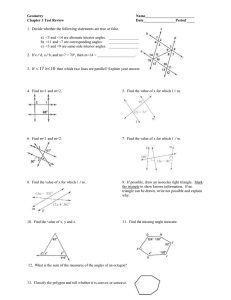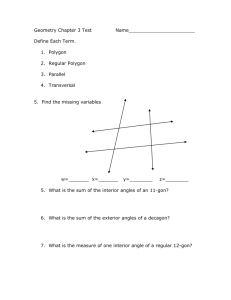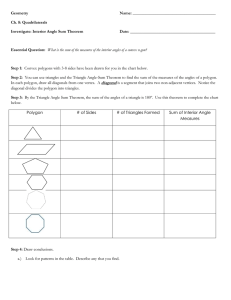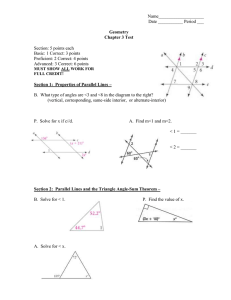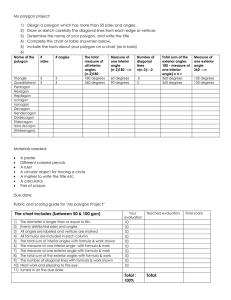Geometry Chapter 3 Test Section: 5 points each
advertisement
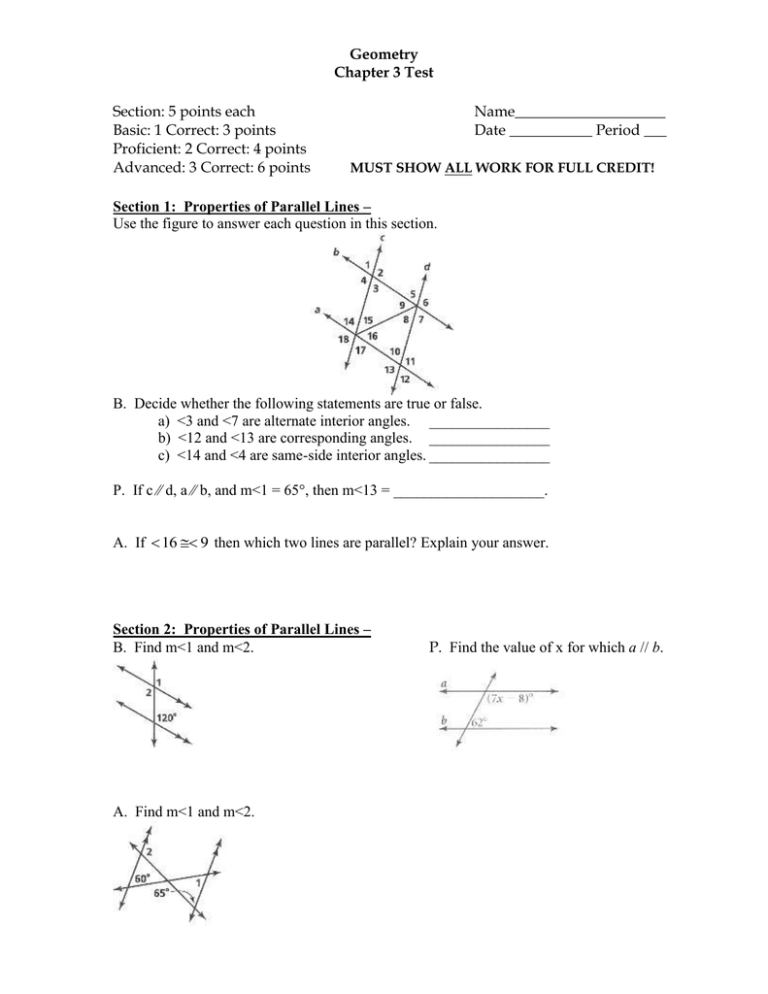
Geometry Chapter 3 Test Section: 5 points each Basic: 1 Correct: 3 points Proficient: 2 Correct: 4 points Advanced: 3 Correct: 6 points Name____________________ Date ___________ Period ___ MUST SHOW ALL WORK FOR FULL CREDIT! Section 1: Properties of Parallel Lines – Use the figure to answer each question in this section. B. Decide whether the following statements are true or false. a) <3 and <7 are alternate interior angles. ________________ b) <12 and <13 are corresponding angles. ________________ c) <14 and <4 are same-side interior angles. ________________ P. If c ∕∕ d, a ∕∕ b, and m<1 = 65°, then m<13 = ____________________. A. If 16 9 then which two lines are parallel? Explain your answer. Section 2: Properties of Parallel Lines – B. Find m<1 and m<2. A. Find m<1 and m<2. P. Find the value of x for which a // b. Section 3: Proving Lines Parallel – B. Find the value of x for which l ∕∕ m. P. Find the value of x for which l ∕∕ m. A. <1 and <2 are corresponding angles. If m<1 = 60 – 2x and m<2 = 70 – 4x, determine the value of x for which the lines that make <1 and <2 are parallel. Section 4: Parallel Lines and the Triangle Angle-Sum Theorem – B. If possible, draw an acute isosceles triangle. Mark the triangle to show known information. If no triangle can be drawn, write not possible and explain why. P. Find the value of x. A. Find the value of x and y, then classify the triangle by its angles. Section 5: The Polygon Angle-Sum Theorems – B. Find the missing angle measure. P. What is the sum of the measures of the interior angles of a heptagon? A. The sum of the measures of the angles of a regular polygon is 4500. How many sides does the polygon have? Section 6: The Polygon Angle-Sum Theorems – B. Classify the following polygon by its sides and then tell whether it is convex or concave. P. What is the sum of the measures of the exterior angles, one at each vertex, of a nonagon? A. The measure of an exterior angle of a regular polygon is given. Find the measure of an interior angle, and find the number of side. 30° Section 7: Lines in a Coordinate Plane – B. Find the slope of the line containing the points A(4, -6) and B(7, 2). P. Graph the line: y = 1 x 3. 2 A. Graph the line using intercepts. 10x + 5y = 40 Section 8: Lines in a Coordinate Plane – B. Write equations for a) the horizontal line and b) the vertical line that contain the point (5, -3). P. Find the slope of the line that contains the points F(-2, 2) and G(0, 8). A. Write an equation for the line described in part P. Section 9: Slopes of Parallel and Perpendicular Lines – B. Are the lines parallel, perpendicular, or neither? y = -3x – 2 3y + 9x = 12 P. What is the slope of the line perpendicular to 6x – 4y = 12? A. Write an equation for the line that is parallel to y = -2x + 1 that contains point C(-3, 5). Section 10: Chapter 1 and 2 Review – B. Find a counterexample to show that this statement is not true. If two angles are complementary, then they are not congruent. P. Find the area of a circle with diameter 14m, leave your answer in terms of π. A. Find the distance between the points C(-1, -1) and D(6, 2) to the nearest tenth. d x2 x1 2 y2 y1 2
